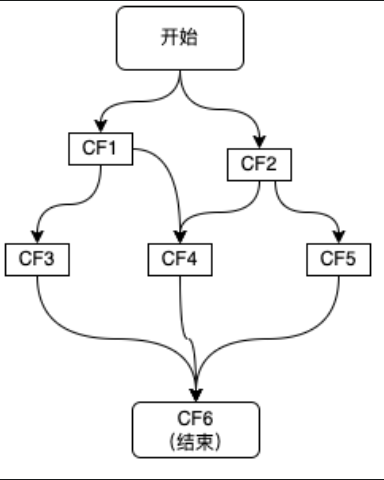深入浅出Future
使用示例
Callable & FutureTask
Callable<String> callableTask = () -> {
TimeUnit.SECONDS.sleep(2);
return "Callable Task Result";
};
FutureTask<String> futureTask = new FutureTask<>(callableTask);
Thread thread = new Thread(futureTask);
thread.start();CompletableFuture<String> completableFuture = CompletableFuture.supplyAsync(() -> {
try {
TimeUnit.SECONDS.sleep(1);
} catch (InterruptedException e) {
throw new IllegalStateException(e);
}
return "CompletableFuture Result";
});深入使用
以下示例来自:CompletableFuture原理与实践-外卖商家端API的异步化 - 美团技术团队 (meituan.com)
CF的使用是基于构造依赖树的,一个CompletableFuture的使用会触发另外一系列依赖它的CF执行

服务依赖
ExecutorService executor = Executors.newFixedThreadPool(5);
CompletableFuture<String> cf1 = CompletableFuture.supplyAsync(() -> "result1",executor);
CompletableFuture<String> cf2 = CompletableFuture.completedFuture("result2");
CompletableFuture<String> cf3 = cf1.thenApply(result -> {
System.out.println("result1: " + result);
return "result3";
});
CompletableFuture<String> cf4 = cf1.thenCombine(cf2, (result1, result2) -> {
return "result4";
});
CompletableFuture<Void> cf6 = CompletableFuture.allOf(cf3, cf4, cf5);
CompletableFuture<String> result = cf6.thenApply(v -> {
result3 = cf3.join();
result4 = cf4.join();
result5 = cf5.join();
return "result";
});
源码解读(基于JDK1.8)
Callable
Callable是用于定义和返回结果,并且可能抛出异常的任务,类似于Runnable
@FunctionalInterface
public interface Callable<V> {
V call() throws Exception;
}FutureTask
先梳理一下继承关系,Future是一个接口,定义了一些属性,然后
public interface RunnableFuture<V> extends Runnable, Future<V> {
void run();
}所以FutureTask就是一个Future的实际实现,是基于Runnable实现的
public class FutureTask<V> implements RunnableFuture<V> {
private volatile int state;
private static final int NEW = 0;
private static final int COMPLETING = 1;
private static final int NORMAL = 2;
private static final int EXCEPTIONAL = 3;
private static final int CANCELLED = 4;
private static final int INTERRUPTING = 5;
private static final int INTERRUPTED = 6;
private Callable<V> callable;
private Object outcome;
private volatile Thread runner;
private volatile WaitNode waiters;
private V report(int s) throws ExecutionException {
Object x = outcome;
if (s == NORMAL)
return (V)x;
if (s >= CANCELLED)
throw new CancellationException();
throw new ExecutionException((Throwable)x);
}
public FutureTask(Callable<V> callable) {
if (callable == null)
throw new NullPointerException();
this.callable = callable;
this.state = NEW;
}
public V get() throws InterruptedException, ExecutionException {
int s = state;
if (s <= COMPLETING)
s = awaitDone(false, 0L);
return report(s);
}
public void run() {
if (state != NEW ||
!UNSAFE.compareAndSwapObject(this, runnerOffset,
null, Thread.currentThread()))
return;
try {
Callable<V> c = callable;
if (c != null && state == NEW) {
V result;
boolean ran;
try {
result = c.call();
ran = true;
} catch (Throwable ex) {
result = null;
ran = false;
setException(ex);
}
if (ran)
set(result);
}
} finally {
runner = null;
int s = state;
if (s >= INTERRUPTING)
handlePossibleCancellationInterrupt(s);
}
}
...
}通过分析源码,我们发现Future获取结果的方式是通过阻塞实现的,会阻塞当前线程,如何避免阻塞呢?
CompletableFuture(以下简称CF)
为何会选择CF呢?
- 可组合:可以将多个依赖操作通过不同的方式进行编排
- 操作融合:将数据流中使用的多个操作符以某中方式组合起来从而降低开销
- 延迟执行
- 学习成本低
- 相比于只能通过阻塞或者轮询获得结果而且不支持回调方法的Future,CF支持回调的方式进行处理结果,同时支持组合操作支持进一步的编排
定义
让我们首先关注它的定义
public class CompletableFuture<T> implements Future<T>, CompletionStage<T> {
...
}可以发现奥秘就在CompletionStage这个接口中,CompletionStage用于标识执行过程中的一个步骤(Stage),从而实现了服务编排
CompletionStage
定义了一系列任务的步骤,具体实现看CompletableFuture是如何实现的
基本属性
public class CompletableFuture<T> implements Future<T>, CompletionStage<T> {
volatile Object result;
volatile Completion stack;
}从这里我们看出,使用了类似于”观察者”模式设计思想,被观察者是CompletableFuture,而观察者是这些需要回调的依赖动作
Completion的定义
Completion是定义在CompletableFuture里的
abstract static class Completion extends ForkJoinTask<Void>
implements Runnable, AsynchronousCompletionTask {
volatile Completion next;
abstract CompletableFuture<?> tryFire(int mode);
abstract boolean isLive();
public final void run() { tryFire(ASYNC); }
public final boolean exec() { tryFire(ASYNC); return false; }
public final Void getRawResult() { return null; }
public final void setRawResult(Void v) {}
}依赖的流程
public <U> CompletableFuture<U> thenApply(
Function<? super T,? extends U> fn) {
return uniApplyStage(null, fn);
}
private <V> CompletableFuture<V> uniApplyStage(
Executor e, Function<? super T,? extends V> f) {
if (f == null) throw new NullPointerException();
Object r;
if ((r = result) != null)
return uniApplyNow(r, e, f);
CompletableFuture<V> d = newIncompleteFuture();
unipush(new UniApply<T,V>(e, d, this, f));
return d;
}
private <V> CompletableFuture<V> uniApplyNow(
Object r, Executor e, Function<? super T,? extends V> f) {
Throwable x;
CompletableFuture<V> d = newIncompleteFuture();
if (r instanceof AltResult) {
if ((x = ((AltResult)r).ex) != null) {
d.result = encodeThrowable(x, r);
return d;
} r = null;
} try {
if (e != null) {
e.execute(new UniApply<T,V>(null, d, this, f));
} else {
@SuppressWarnings("unchecked") T t = (T) r;
d.result = d.encodeValue(f.apply(t));
} } catch (Throwable ex) {
d.result = encodeThrowable(ex);
} return d;
}
final void unipush(Completion c) {
if (c != null) {
while (!tryPushStack(c)) {
if (result != null) {
NEXT.set(c, null);
break;
}
}
if (result != null)
c.tryFire(SYNC);
}
}- 简单理解一下就是,在CF完成任务时,会去观察者链中出栈一个,然后执行,并且返回一个新的CompletableFuture,然后后续继续去完成后续依赖任务
- 如果原始任务还没完成,那么就会将新的任务推入栈中,等待原始任务完成
执行过程
以 supplyAsync为例
public static <U> CompletableFuture<U> supplyAsync(Supplier<U> supplier,
Executor executor) {
return asyncSupplyStage(screenExecutor(executor), supplier);
}
private static final Executor ASYNC_POOL = USE_COMMON_POOL ?
ForkJoinPool.commonPool() : new ThreadPerTaskExecutor();
public static <U> CompletableFuture<U> supplyAsync(Supplier<U> supplier) {
return asyncSupplyStage(ASYNC_POOL, supplier);
}
static <U> CompletableFuture<U> asyncSupplyStage(Executor e,
Supplier<U> f) {
if (f == null) throw new NullPointerException();
CompletableFuture<U> d = new CompletableFuture<U>();
e.execute(new AsyncSupply<U>(d, f));
return d;
}通过阅读源码,我们可以发现,原来CompletableFuture执行任务是会使用线程池去执行的,相比FutureTask通过阻塞去等待结果,确实是提升了性能。
关于线程池的源码和原理解析,以及一些八股知识,欢迎翻看鄙人的另一篇《深入浅出线程池》博客观看























 被折叠的 条评论
为什么被折叠?
被折叠的 条评论
为什么被折叠?








